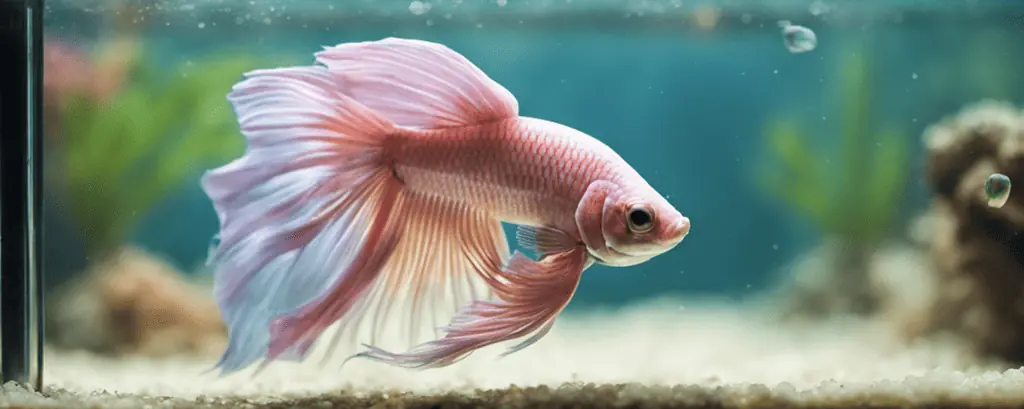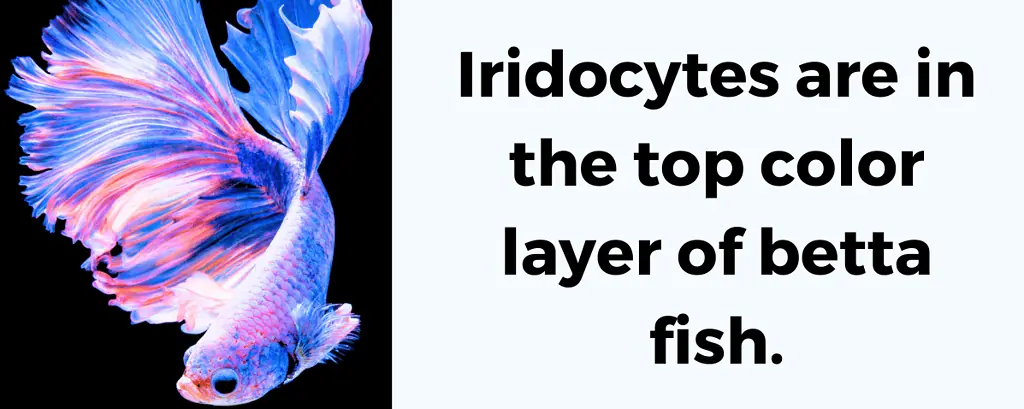Betta fish are well-known for having vibrant colors and a flashy appearance.
But the pastel betta turns this notion upside-down!
Pastel bettas have softer colors, giving them a more delicate appearance.
The pastel variation isn’t the only pale-colored betta.
Opaque and grizzle varieties have a similar appearance to pastel bettas.
So, how do you tell the difference between pastel bettas and other pale color variations?
In this article, we discover what makes pastel bettas unique and discover the genetics of this pale coloration.
Table of Contents
What Is a Pastel Betta?

Pastel bettas have pale-colored bodies and fins.
They also have a steel blue, blue, or green iridescent sheen.
This iridescence occurs in varying degrees on the body and fins but is always present.
Many pastel bettas have almost translucent fins with hints of pale color.
Pastel bettas have solid-colored bodies but may have several colors on their fins.
Common colors in pastel bettas include pale shades of:
- Green
- Blue
- Pink
- Yellow
- Orange
If a pastel betta has a red base color, the top layer of blue iridescence can make the fish appear lavender.
Pastel bettas can have any tail type, including:
- Halfmoon
- Delta tail
- Veiltail
- Crowntail
- Rosetail
- Halfmoon plakat
Pastel female bettas are close in color to males but have shorter fins.
What Is the Difference Between a Pastel and an Opaque Betta?

The major difference between these two betta varieties is the amount of opaque pigment cells.
Pastel bettas contain only a small amount of the opaque factor.
A pastel betta must have some degree of opaque genes so the iridescence appears more solid.
Without any opaque cells, a betta becomes translucent. This makes the fish a cellophane betta.
Cellophane bettas are in a different category than pastel or opaque bettas.
These bettas are so transparent their internal organs are visible.
Opaque bettas have a high amount of opaque pigment cells. This gives their body scales a powdery appearance.
An opaque betta also has thick deposits of opaque pigment cells on its head.
These dense pigment cells usually do not extend to the head in pastel bettas.
So, in a technical sense, opaque bettas are also pastels. But not all pastel bettas are opaques.
Are Grizzle Bettas Pastels?

The grizzle coloration is one of the most unique varieties of betta fish.
These bettas have a pastel body with specks of iridescent coloring on the body and fins.
A grizzle betta’s colors blend like someone painted the fish with watercolors.
The ideal grizzle betta should have 50% iridescence and 50% opaque or pastel coloration.
While grizzle bettas have pastel colors, they are not true pastel bettas.
A true pastel betta must have solid-color body scales without any color irregularities.
Despite their appearance, grizzle bettas do not carry marble genes.
The specks of color on a grizzle betta blend in a gradient on the body and fins.
Only two colors usually appear on a grizzle betta.
Marble bettas can have three or more colors, forming distinctive color patterns on the body and fins.
A marble betta usually has more vivid colors than the soft pastels in the grizzle pattern.
While marble and grizzle patterns come from mutated genes, the grizzle pattern is more stable.
Marble bettas can change colors several times throughout their lives.
The International Betta Congress considers the grizzle pattern a fault in regular pastel bettas.
This puts grizzle bettas in a category of their own.
Are Pastel Bettas Rare?

The pastel variation is not a common betta fish color.
You likely won’t find a pastel betta in your local pet store.
The pastel coloration does not exist in wild betta fish. This color pattern only exists through selective breeding.
Few breeders specialize in pastel bettas because they are not in high demand.
Betta fanciers usually prefer multi-colored betta fish with vivid colors.
Pastel betta fish breeding is also a difficult process due to the complex genetics of these beautiful fish.
Most of the traits needed for a pastel coloration rely on recessive genes.
The Average Cost of a Pastel Betta

Pastels are expensive betta fish with a cost ranging from $20 to $50 or more.
The price of a pastel betta depends on the quality of the body color.
A clean body color without spots or defects costs more than a pastel betta with a grizzle pattern.
Fin types are another factor affecting the price of a pastel betta.
More elaborate fin types like the over halfmoon and rosetail are always the most expensive.
Expect shipping costs ranging from $15 to $40 when buying a pastel betta from an online breeder.
Always read a breeder’s shipping policies and ensure they have a “live on arrival” guarantee.
Also, make sure the betta in the advertised picture is the one you are getting.
Some less-reputable breeders may use bad lighting or altered photos when advertising their bettas.
You may even see betta breeders use stock photos as placeholders.
Read several reviews left by previous buyers if you are unsure of a betta breeder’s reputation.
If you are ever uncomfortable buying a betta from a particular breeder, search for a different one.
Betta fish are a long-term commitment, so be patient when finding the right one.
The Breeding History of Pastel Bettas

We don’t know much about the breeding history of pastel bettas.
The pastel color is likely the result of a genetic mutation when breeding opaque bettas.
Dr. Gene Lucas first developed opaque bettas in the early 1960s.
Opaque and pastel bettas share almost the same genetics.
The only difference between them is the percentage of opaque pigment cells these fish carry.
Some offspring were likely pastels if a genetic mutation occurred when breeding opaque bettas.
We can learn more about the possibility of this outcome with a better understanding of the color layers present in bettas.
Betta Fish Color Layers

Domestic Betta splendens have four color layers:
- Iridescent (Top)
- Black
- Red
- Yellow (Bottom)
Each of these layers contains several types of pigment cells.
Certain combinations of pigment cells in each layer determine the physical color of a betta.
Iridescent Layer
The iridescent layer controls the iridescence and blue pigmentation in betta fish.
Pigment cells on this layer, known as iridocytes, are either steel blue, royal blue, or green.
Since iridocytes are in the top color layer, they influence how colors on the lower layers appear.
Black Layer
Melanophores are the pigment cells in the black layer.
As you might have guessed, these cells control the amount of black pigment seen in bettas.
The black color layer includes the Cambodian gene. This gene removes dark body pigment.
Cambodian betta fish have pale or flesh-colored bodies.
Red Layer
Pigment cells on the red layer are erythrophores. These cells control the amount of red coloration in bettas.
Extended red genes produce a red pigment on the betta’s body and fins.
Reduced red genes produce a red color only on the betta’s fins.
The non-red gene results in the complete absence of red pigment.
Genes for variegated fins are also on the red color layer. Variegated fin genes create butterfly patterning.
Yellow Layer
At the bottom is the yellow layer, which contains pigment cells called xanthophores.
Despite the name, this layer does not control yellow pigmentation in bettas.
Yellow bettas result from lacking blue, red, and black pigment cells in the other layers.
Dr. Gene Lucas concluded the yellow layer may have some control over opaque genes.
Opaque genes create a white, powdery appearance on a betta’s scales.
Since the opaque trait has partial dominance, it can override recessive genes in other color layers.
Pastel Betta Genetics
Now you have an understanding of the color layers in betta fish.
Let’s take a closer look at how these color layers work together in pastel bettas.
Pastel bettas have a spread of iridocyte pigment on their bodies and fins.
The iridocyte pigments found in pastel bettas are steel blue.
Steel blue pigments show a silvery-white sheen on pale skin under bright light.
Colors underneath this top layer can also make this iridescence appear blue or green.
Another special trait in pastel bettas is the Cambodian gene.
Cambodian genes remove dark body pigment. This gives the pastel betta its pale body color.
Pastel bettas also have the non-red gene found in the red layer.
The non-red gene is a mutation of the extended red gene. It removes red pigment from the red color layer.
Bettas carrying the non-red gene can have yellow or orange colors. In pastel bettas, this appears as a buttery yellow or pale orange.
Finally, there are the opaque genes in the bottom color layer.
All pastel bettas have some form of the opaque gene.
The opaque gene creates a milky white color under the other color layers.
This produces pastel versions of all the other colors in a betta.
The body and fins appear more translucent when a betta has a low opaque factor.
In pastel bettas, fewer opaque cells result in almost-translucent fins. Sometimes, only the fin edges appear translucent.
If a pastel betta has too many opaque cells, it is no longer a pastel. Instead, the fish gets classified as an opaque betta.


